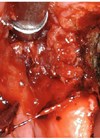
Professor Wolfgang Steiner.
Wolfgang Steiner inspired a whole generation of head and neck surgeons. Terry Jones gives us his own personal perspective.
“We are like dwarfs on the shoulders of giants, so that we can see more than they, and things at a greater distance, not by virtue of any sharpness of sight on our part, or any physical distinction, but because we are carried high and raised up by their giant size.”
Bernard of Chartres, 12th Century
My career as a transoral surgeon happened purely by chance. Having committed early to a career in head and neck oncology, Liverpool was the ideal place to train. In the late 90s / early 2000s, historical serendipity had resulted in the presence of two world-class head and neck surgical oncology units: an academic otolaryngology unit, set-up and led initially by Professor Philip Stell – who pioneered head and neck surgery in the UK – and, later, Professor Andrew Jones and a maxillofacial unit (MFU) led by Mr David Vaughan and Mr James Brown.
Despite, or perhaps because of, the international reputations enjoyed by each department, harmonious relationships between the big beasts of each department were, during the 90s, in short supply. This frisson, however, proved to be the engine of the interdisciplinary competition which drove each department to achieve the international repute they both enjoyed.

Professor Philip Stell.
The training experience was outstanding, made better in the early 2000s as relations began to thaw and both departments pooled resources, ensuring the genesis of the fully integrated centre that exists today. Huge resections with pioneering reconstruction were commonplace, happening four or five times a week, and the ability to get involved surgically, even at a relatively junior stage of training, was not only encouraged, it was expected.
"I decided to learn a bit more about transoral surgery, if only to reinforce my views at the time that it was nonsense"
My ‘fellowship’ training was a precursor of an early TIG Fellowship. As relationships were increasingly harmonious, I was, in the later part of training, ‘seconded’ to the MFU for a six-month locum post to learn microvascular reconstruction. Armed with this inimitable training experience, I was appointed as a H&N consultant in 2003, fully expecting that the rest of my career would continue in the same vein of major resection and reconstruction.
In 2003, Martin Birchall was appointed as the first professor of head and neck surgery (rather than otolaryngology) in Liverpool, following the retirement of Andrew Jones. Martin was (and is) a renowned laryngologist and, consequently, his appointment was accompanied by the purchase of a significant amount of specialist laryngology instruments, none of which any of us had ever seen before.
Martin’s tenure was, unfortunately, short and he left Liverpool in 2005, leaving the laryngology kit behind. Discussions ensued as to what we should do with it; sell it off or think about using it – an idea to which none of us macho H&N surgeons were favourably disposed. However, for reasons that I no longer remember, I decided to learn a bit more about transoral surgery, if only to reinforce my views at the time that it was nonsense.
The obvious place to learn more was to attend the live-surgery Transoral Laser Microsurgery (TLM) Course run by Professor David Howard in the Royal National Throat Nose and Ear (RNTNE) in London. David, who having earned an international reputation as a ‘traditional’ head and neck surgeon, had seen the benefits of TLM and had committed to proselytising it in the UK. This pioneering annual course included Professor Wolfgang Steiner as the ‘star-turn’, together with Professor Petra Ambrosch who had worked closely with Prof Steiner in Göttingen to take the technique to new heights and, most importantly, to collate the data which provided the evidence base for the effectiveness and ultimate adoption worldwide of this groundbreaking surgical approach. Prof Steiner was his expected irrepressible self, completely convinced, and therefore attempting to convince us, that TLM was the only valid technique for much of H&N surgery.
"Prof Steiner was his expected irrepressible self, completely convinced, and therefore attempting to convince us, that TLM was the only valid technique for much of H&N surgery"
A fortuitous placement at lunch, next to Prof Ambrosch, provided a more measured approach as to the limitations and indications of the technique, as well as an invitation to visit her in Keil, to observe, first hand, TLM in practice. The subsequent visit to Keil changed my life course: Prof Ambrosch’s approach to TLM was highly convincing and, when combined with the compelling published data, served as the stimulus for me to retrain as a TLM surgeon.
Whilst this change of direction could not have happened without the support of colleagues in Liverpool (none of the laryngology kit was fit-for-purpose and so our early foray into TLM is a story in itself), it certainly couldn`t have happened without the huge support provided by David and Petra, to whom I will remain forever indebted. Both became good friends, and little did I know that two years after I attended the RNTNE course, I would be hosting the course in Liverpool and Petra and David would be the ‘star turns’ on the faculty.
The real irony of this story is that the two giants who, as a consequence of their truly pioneering contributions to head and neck surgery and TLM, have had the biggest bearing on my professional life, I never really met. I attended an ORS meeting in Liverpool at which Professor Stell was presiding, and the TLM meeting described above when Professor Steiner was present, but, regretfully, I never had a meaningful conversation with either.
Despite that, there is no doubt that I, together with David, Petra and many, many others have benefitted from the expansive view provided by standing on their shoulders for all these years and we should be forever grateful to them.










